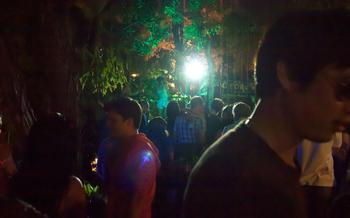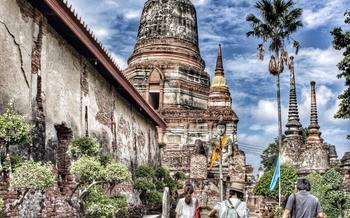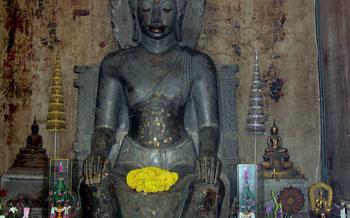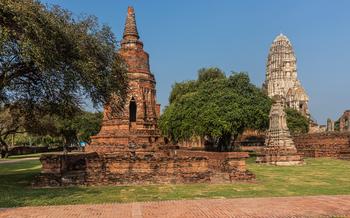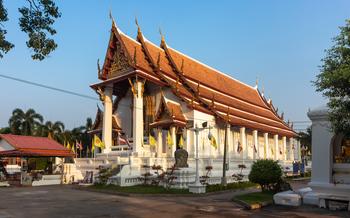
Wat Maha Wanaram
- History of the Temple
- Worship and Religious Practices
- Architectural Marvels
- Spiritual Atmosphere
- Pilgrimage and Tourism
- Community Involvement
- Unique Features
- Festivals and Celebrations
- Local Cuisine
- Accommodation and Transportation
- Guided Tours and Workshops
- Sustainable Tourism
History of the Temple
Wat Maha Wanaram is a significant Buddhist temple in Thailand's Ubon Ratchathani province, holding immense historical and cultural importance. Founded in the 16th century, it is one of the oldest temples in the region and has witnessed centuries of devotion, architectural evolution, and spiritual growth.
The temple's unique architectural style blends traditional Thai and Khmer elements, reflecting the region's rich cultural heritage. Its most striking feature is the central prang, or tower, which rises majestically above the temple complex. The prang is adorned with intricate carvings and sculptures, showcasing the exceptional craftsmanship and artistry of the ancient builders.
Throughout its history, Wat Maha Wanaram has been home to influential monks who have dedicated their lives to preserving and propagating Buddhism. Their teachings and practices have left an indelible mark on the temple's spiritual and religious significance.
The temple is also associated with legendary tales and local beliefs that have been passed down through generations. These stories often involve miraculous events, supernatural beings, and the temple's sacred relics, adding to its mystique and allure.
Worship and Religious Practices
Wat Maha Wanaram is an active Buddhist temple where religious rituals and ceremonies are performed daily. The temple's ordination hall, prayer rooms, and Buddha images serve as important spaces for worship, meditation, and spiritual contemplation.
Buddhist Rituals and Ceremonies: - Morning alms-giving ceremonies, known as "Tak Bat," are held daily where devotees offer food to monks. - Ordination ceremonies, where young men enter the monkhood, are significant events accompanied by traditional rituals. - Weekly meditation sessions and Dharma talks are conducted by resident monks, providing insights into Buddhist teachings. - Special ceremonies and festivals, such as Visakha Puja and Kathina, celebrate important Buddhist holidays and attract a large number of devotees.
Local Traditions and Festivals: - Loi Krathong, the festival of lights, is celebrated at the temple with the release of floating lanterns on the nearby lake, creating a magical atmosphere. - Songkran, the Thai New Year, is celebrated with water-splashing festivities, as locals and visitors gather at the temple to seek blessings and participate in traditional activities. - Local traditions, such as merit-making and the offering of flowers and candles, are deeply ingrained in the temple's practices and contribute to its spiritual significance.
Etiquette and Customs: - When attending religious ceremonies, visitors are expected to dress respectfully and maintain silence. - Shoes should be removed before entering the temple's sacred spaces. - It is customary to bow or wai in front of Buddha images as a sign of reverence. - Visitors should be mindful of their actions and speech, respecting the temple's peaceful and meditative atmosphere.
Architectural Marvels
Wat Maha Wanaram stands as a testament to the architectural prowess of ancient Thai artisans. Its design showcases a harmonious blend of traditional Thai and Khmer influences, creating a visually stunning and awe-inspiring sanctuary. The temple's most striking feature is its towering central prang, which pierces the skyline and serves as a symbol of religious devotion. The prang is adorned with intricate carvings depicting scenes from Buddhist mythology, adding a touch of spirituality to its architectural grandeur.
The temple's exterior walls are adorned with a series of bas-reliefs that narrate the life of Buddha and significant events in Buddhist history. These intricate carvings provide a glimpse into the religious beliefs and values of the ancient Thai people. The bas-reliefs are a testament to the skill and artistry of the craftsmen who created them, and they add a layer of depth and meaning to the temple's architecture.
Inside the temple, visitors can marvel at the exquisite murals that cover the walls and ceilings. These murals depict scenes from Thai mythology, history, and everyday life, providing a glimpse into the culture and traditions of the ancient Thai people. The murals are painted with vibrant colors and intricate details, creating a sense of awe and wonder for visitors.
Wat Maha Wanaram's architecture is not only aesthetically pleasing but also symbolically significant. The temple's layout, orientation, and design elements are all imbued with religious meaning and symbolism. For example, the temple's central prang represents Mount Meru, the mythical abode of the gods, while the surrounding stupas represent the eight directions of the universe.
When compared to other significant temples in Thailand, Wat Maha Wanaram stands out for its unique architectural style and features. While many temples in Thailand share similar design elements, Wat Maha Wanaram's Khmer influence and exquisite craftsmanship set it apart. The temple's towering prang, intricate carvings, and vibrant murals create a visually stunning and awe-inspiring experience that is sure to leave visitors in awe.
Spiritual Atmosphere
Within the hallowed grounds of Wat Maha Wanaram, a palpable sense of serenity and tranquility pervades the air. The temple exudes an aura of peace and harmony, inviting visitors to immerse themselves in a spiritual journey of self-reflection and growth.
-
Meditation Practices: The temple offers guided meditation sessions for visitors seeking inner peace and spiritual enlightenment. These sessions are conducted by experienced monks who provide instruction on various meditation techniques, allowing participants to quiet their minds, connect with their inner selves, and cultivate a deeper understanding of Buddhist teachings.
-
Spiritual Retreats: For those seeking a more immersive spiritual experience, Wat Maha Wanaram offers residential retreats that provide participants with the opportunity to fully dedicate themselves to spiritual practices. These retreats typically involve daily meditation sessions, teachings from monks, and opportunities for self-reflection and contemplation.
-
Peaceful Environment: The temple's serene surroundings, lush gardens, and tranquil atmosphere create an ideal environment for spiritual pursuits. Visitors can wander through the temple grounds, find a quiet spot to meditate, or simply sit in contemplation, surrounded by the beauty and tranquility of the temple's natural surroundings.
-
Personal Transformations: Many visitors to Wat Maha Wanaram have reported profound spiritual experiences during their visits. Some have found solace and healing, while others have experienced a renewed sense of purpose and direction in their lives. The temple's peaceful atmosphere and the teachings of the monks have had a transformative impact on countless individuals, leaving a lasting impression on their spiritual journeys.
Pilgrimage and Tourism
Wat Maha Wanaram's religious significance has transformed it into a renowned pilgrimage destination for Buddhists from Thailand and beyond. Devotees flock to the temple to pay homage to Buddha images, offer prayers, and seek spiritual guidance. The temple's serene atmosphere and reputation for spiritual power draw pilgrims who seek blessings, peace of mind, and a deeper connection with their faith.
In recent years, Wat Maha Wanaram's fame has extended beyond religious circles, attracting a growing number of local and international tourists. The temple's architectural beauty, historical significance, and cultural charm have captivated visitors from around the world. The influx of tourists has contributed to the preservation of the temple's heritage and traditions while simultaneously boosting the local economy.
As Wat Maha Wanaram's popularity continues to rise, it plays a crucial role in promoting cultural understanding and religious tolerance. By welcoming visitors from diverse backgrounds, the temple fosters a sense of unity and encourages people to learn about and appreciate different cultures and beliefs.
Community Involvement
Wat Maha Wanaram plays a pivotal role in fostering community spirit and social cohesion within the local community. The temple serves as a gathering place for residents, promoting a sense of unity and belonging. It organizes educational and charitable initiatives that benefit the community, such as providing educational scholarships for underprivileged students and hosting free healthcare clinics for the elderly. The temple also organizes community events, gatherings, and festivals that bring people together to celebrate their shared culture and traditions. Furthermore, the temple collaborates with local organizations to implement community development projects, such as improving infrastructure and supporting local businesses. Through these initiatives, Wat Maha Wanaram strengthens the bonds within the community and contributes to its overall well-being.
Unique Features
Wat Maha Wanaram stands out from other temples with its distinctive elements that captivate visitors' attention. Its most remarkable feature is the Phra Ubosot, or ordination hall, which is entirely made of black stone. This unique construction sets it apart from other temples in Thailand, where the Ubosot is typically made of gold or white marble.
The temple also houses several ancient artifacts and relics, including a rare collection of Buddha images from different eras. These statues showcase the evolution of Buddhist art and provide a glimpse into the rich history of the temple.
Moreover, Wat Maha Wanaram is steeped in local legends and mysteries. One intriguing tale revolves around a hidden treasure believed to be buried within the temple grounds. This legend has captivated the imagination of locals and visitors alike, adding an air of intrigue to the temple's already rich history.
Festivals and Celebrations
Wat Maha Wanaram comes alive during festivals and celebrations, showcasing the vibrant traditions and cultural heritage of Ubon Ratchathani. The most prominent festival is Songkran, the Thai New Year, celebrated in April. The temple grounds transform into a lively hub of activity, with water splashing, parades, and merit-making ceremonies.
Loi Krathong, the Festival of Lights, held in November, is another significant event. During this festival, visitors can witness the enchanting sight of thousands of candlelit krathongs (floating baskets) released onto the nearby river, creating a beautiful spectacle.
Buddhist holidays, such as Visakha Bucha and Asalha Puja, are also celebrated with fervor at Wat Maha Wanaram. These occasions mark important events in the life of Lord Buddha and are observed with prayer ceremonies, chanting, and meditation sessions.
To make the most of your visit, plan your trip to coincide with one of these festivals. Immerse yourself in the festive atmosphere, participate in the rituals, and witness the vibrant expressions of faith and devotion.
Local Cuisine
A visit to Wat Maha Wanaram can be complemented by a culinary journey through the local flavors of Ubon Ratchathani. The temple's surroundings are dotted with street food stalls and local markets, offering an array of authentic Thai dishes that tantalize the taste buds. From spicy papaya salads to aromatic noodle soups, there's something to satisfy every palate.
For those seeking vegetarian options, there are several restaurants near the temple that cater to different dietary preferences. Whether you're a fan of tofu, vegetables, or mock meats, you'll find delicious and nutritious dishes that honor the temple's Buddhist principles.
Among the must-try local specialties is the famous "Khao Jee" or sticky rice, a staple of the northeastern Thai cuisine. Served with savory dipping sauces and grilled meats, it's a flavorful and filling dish that's sure to leave you wanting more.
So, after exploring the spiritual wonders of Wat Maha Wanaram, take some time to indulge in the culinary delights of Ubon Ratchathani. Embrace the vibrant street food culture, savor the local delicacies, and let the flavors of Thailand enchant your senses.
Accommodation and Transportation
Accommodation
A variety of accommodation options are available near Wat Maha Wanaram, catering to different budgets and preferences. For a budget-friendly stay, there are several guesthouses and hostels within walking distance of the temple. These offer basic amenities and a comfortable place to rest after a day of exploration.
For those seeking more comfort and convenience, there are several mid-range and luxury hotels in the vicinity. These offer a range of amenities, including swimming pools, fitness centers, and rooftop bars, providing a relaxing and enjoyable stay.
Transportation
Wat Maha Wanaram is easily accessible by public transportation. Several bus routes pass near the temple, and there are also tuk-tuks and taxis readily available. For those who prefer to explore at their own pace, rental vehicles, including cars and motorbikes, can be arranged through local vendors.
The temple provides ample parking space for visitors arriving by car or motorbike. Additionally, there are designated areas for visitors with disabilities, ensuring accessibility for all.
Tips
-
When choosing accommodation, consider factors such as proximity to the temple, budget, and desired amenities.
-
To get the most out of your visit, plan your transportation in advance, especially if you're using public transportation.
-
Renting a bicycle is a great way to explore the surrounding area and visit other nearby temples.
-
Tuk-tuks and taxis are convenient options for short distances and can be negotiated for a reasonable fare.
Guided Tours and Workshops
To delve deeper into the rich history and cultural significance of Wat Maha Wanaram, guided tours are highly recommended. Knowledgeable guides provide insightful commentary, shedding light on the temple's architectural marvels, religious practices, and local legends. These tours typically cover the main highlights of the temple complex, including the ordination hall, prayer rooms, and Buddha images. Some tours may also include a visit to the temple's museum, which houses a collection of artifacts and relics related to its history.
For a more immersive experience, visitors can participate in workshops offered by the temple. These workshops provide hands-on opportunities to learn about traditional Thai crafts and practices. Popular workshops include meditation sessions, where visitors can experience the tranquility of the temple grounds while learning the basics of meditation. Other workshops focus on traditional Thai arts, such as flower arrangement, fruit carving, and even cooking classes featuring local cuisine.
To book a guided tour or workshop, visitors can contact the temple office directly or inquire at their hotel or guesthouse. Fees vary depending on the type of tour or workshop and the number of participants. Advance booking is recommended, especially during peak tourist season.
Sustainable Tourism
As a responsible traveler, it's essential to practice sustainable tourism at Wat Maha Wanaram. Here are some tips to minimize your environmental impact and contribute to the well-being of the local community:
-
Reduce Plastic Waste: Avoid single-use plastic items like water bottles and plastic bags. Bring your reusable water bottle and shopping bags.
-
Support Local Businesses: Choose to eat at local restaurants and buy souvenirs from local vendors. This supports the local economy and preserves the unique character of the area.
-
Respect Wildlife: The temple grounds are home to various wildlife, including birds, squirrels, and fish. Observe them from a distance and avoid disturbing their habitats.
-
Conserve Water and Energy: Be mindful of your water and electricity usage at the temple. Turn off lights and fans when not in use, and take shorter showers.
-
Participate in Conservation Efforts: If possible, get involved in conservation initiatives organized by the temple or local organizations. This could include tree planting, waste management, or community clean-up activities.
By practicing sustainable tourism, you can help protect the environment and ensure that Wat Maha Wanaram remains a vibrant and thriving temple for generations to come.

